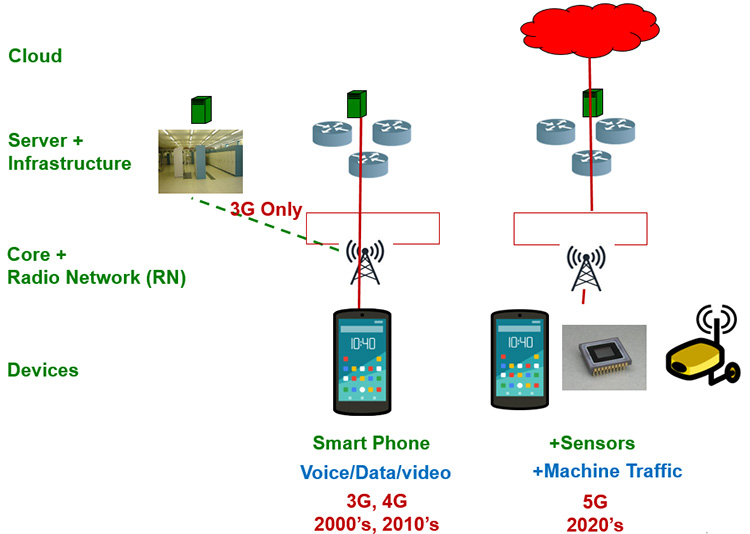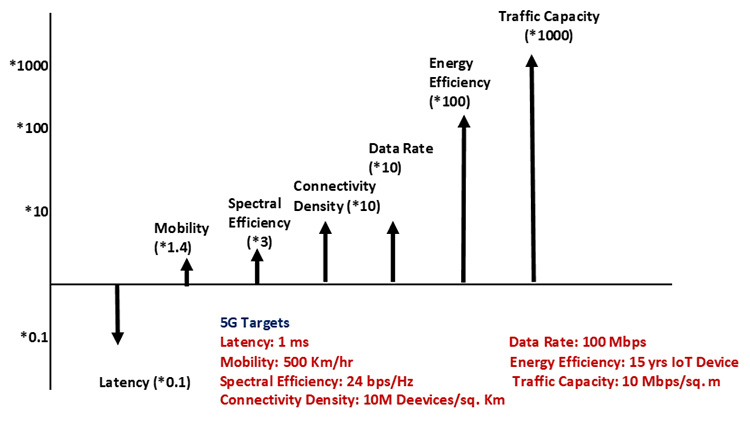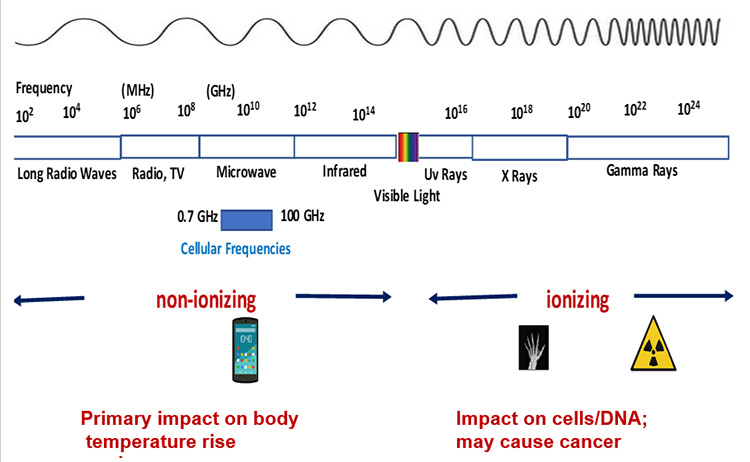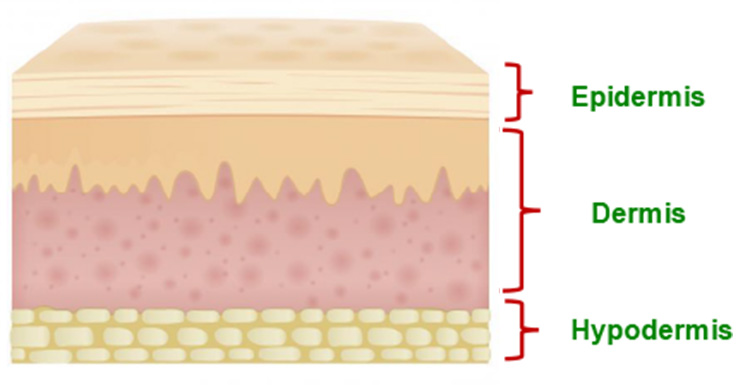Abstract
5G is a paradigm shift into the domain of handling massive Machine Type Communication (MTC) traffic for supporting the Internet of Things (IoT) network in addition to providing significantly higher performance for traditional voice. data, and video applications. It utilizes a Cloud based Radio Access Network (C-RAN) and a Core. The C-RAN has unique capabilities including a Non-Orthogonal Multiple Access (NOMA) scheme, massive Multiple Input Multiple Output (MIMO) antenna array system, user oriented steerable beams, and operations in the mmWave frequency region. There is additional research needed to ensure safe operation of the 5G system so that it will not have adverse effect on humans, animals, vegetation, and the environment while operating in the mmWave spectrum. 5G core provides the framework for creating flexible services based on Network Slicing. Network slicing allows customization and optimization for “individual” applications and services based on use of cloud based Software Defined Networking (SDN) and Network Function Virtualization (NFV) capabilities.
Introduction
As we enter the era of intelligent applications and services including smart cities, smart energy, smart transportation, and smart health among others. 5th Generation (5G) Wireless is a key advanced access enabler for the associated Internet of Things (IoT) network. The intent of this paper is to provide the framework for 5G technology in terms of its evolution from 4G standard, the technological advances provided in implementing the standard, and unique expansion of its operation to the new mmWave frequency region. The primary issues being addressed in this paper can be paraphrased as
- How is 5G different from 4G Long Term Evolution (LTE) and what value does it offer?
- What are the technical advances in 5G?
- What actions can be taken to mitigate the health and other adverse effects of mmWave operations?
How is 5G different from 4G and what value does it offer?
4G LTE cellular technology is primarily targeted towards human-oriented voice, data, and video applications [1, 2]. Narrow Band-IoT (NB-IoT) and LTE Cat M1 (LTE-M) were key initiatives by the 4G LTE technology to address Low Power Wide Area Network (LPWAN)-oriented applications [3]. The upcoming 5G technology is a fundamental paradigm shift from 4G LTE [4,5]. In addition to handling human-oriented voice, data, and video-based applications at significantly higher performance and functionality, 5G is being designed to address Machine Type Communication (MTC) applications in the IoT space [6]. Architecturally, 5G uses 4G hardware as the foundation. Capabilities are formed in terms of adaptable software functions based on “cloudization”.

Figure 1: Cellular Wireless Evolution
The Key Performance Indicator (KPI) improvements in 5G in reference to 4G technology are summarized in Figure 2.

Figure 2: 5G Key Performance Indicators (KPI) with respect to 4G
What are the technical advances in 5G?
5G builds upon the key capabilities in 4G by providing several major improvements. Particular attention is placed on mmWave operations to handle mmWave operations. These include:
- High path loss due to higher carrier frequency,
- Deterioration in propagation characteristics due to environmental issues, e.g., humidity and rain, and
- Susceptibility to blockage.
These have significant impacts. Coverage is significantly reduced, typically to a 1 Km range and may have major gaps. There is significant attenuation in the range of 10-4 db/m and 10-2 db/m around 25 GHz and 60 GHz regions respectively and almost continuous attenuation of 10-2 db/m for rain rates higher than 25 mm/hr [7]. Devices which are not in line-of-sight cannot be accessed. There is limited in-building penetration which does not allow devices like meters inside the building or in the basement to communicate with the network.
The major advances provided in 5G Wireless are summarized in Table I.
TABLE I: 5G Technological Advances
| Characteristic | Technological Advance | Comments |
| Customer Experience Improvement | Priority Management | Quality Class Identifier (QCI) Based User Traffic Bearer |
| Network Slicing | Customization and optimization for “individual” application based on use of Cloud based Software Defined Networking (SDN) and Network Function Virtualization (NFV) capabilities | |
| Multi Radio Access Technolo-gies (RAT) support – 4G, WiFi | Interworking and interface with 4G LTE and WiFi Radio Networks | |
| Latency Improvements | Reduced Transmission Time Interval (TTI) (0.1 ms) | Number of Consecutive symbols for one Transmission in time domain |
| Mobile Edge Computing (MEC) | Coordinated data computing between the cloud, the edge core / Radio Network, and the device | |
| Flexible Slots | Fast UL/DL turn-around and scalable slot durations | |
| Cyber Security | Multi domain security and trust models to handle Network and Edge Processing security vulnerabilities, User identity threats, and device data risks | |
| Mobility Improvements | Split between Control and User Planes | Specialized user planes for different applications |
| Efficient Handovers | Separate radio networks during Handovers | |
| High Data Rates | Improve Spectral Efficiency | Higher 256 / 512 Quadrature Amplitude Modulation (QAM) |
| Carrier Aggregation | Combine two or more carriers even in different bands into one data channel | |
| Higher Frequency bandwidth | Up to 100 MHz in sub 6 GHz and 500 MHz in mmWave Operations | |
| Traffic Capacity Improvements | Non Orthogonal Multiple Access (NOMA) | Scalable-OFDM (SC-OFDM) Using Power domain techniques |
| Channel Dependent Scheduling | Allocate time frequency resources to user with highest Channel Quality | |
| Multiple Input Multiple Output (MIMO) Antennas | Use time and space diversity to handle path loss, manage interference, and increase coverage | |
| Steerable Beams | Use MIMO to focus energy into narrow beam directed towards mobile User Equipment (UE) | |
| Coverage Improvements | Fast Link Adaptation | Match modulation, coding and other signal and protocol parameters to the conditions on the radio link |
| Coordinated Multi Point (CoMP) | Cooperatively enhance the signal from two different radio networks | |
| Mesh Networking | Use individual routers / nodes and gateways for a consolidated interface to the radio network | |
| Energy Efficient Operation | Reduce power consumption during UE idle mode | Use Power Save Mode (PSM) and extended Discontinuous Reception (eDRX) techniques to reduce power transmission |
| Reliability | Advanced Channel Coding | Multi Edge- Low Density Parity Check (ME-LDPC) and CRC-Aided Polar (CA-Polar) codes for user plane data transmission and Control Physical Channel integrity |
| Hybrid-Automatic Repeat reQuest (HARQ) | Improve transmission integrity via combining multiple error detection coded packets |
What actions can be taken to mitigate the health and other adverse effects of mmWave operations?
An area of concern in mmWave propagation is the uncertain environmental and health impact of mmWave radiation. Figure 3 shows how the cellular operations both in the sub-6 GHz and mmWave frequencies form part of the overall Electromagnetic spectrum.

Figure 3: Health Impact of EM Spectrum
In the frequencies in which the cellular systems operate, the effect on human body is non-ionizing implying that the energy is able to knock the electrons to a higher state, i.e. thermal energy, but not knock electrons out of orbit. In the sub-6GHz frequency range, EM waves penetrate up to tissues just below the skin. The measure used is Specific Absorption Rate (SAR) with the International safe limits being defined as 0.08 W/Kg for the whole body with more stringent localized limits [8]. This results in mobile devices and base stations limited to 6 W and 500 W power radiation respectively. Experience of 30+ years has indicated no adverse health outcomes due to exposure within these safe limits thus repudiating the notion that mobile phone use can cause brain tumors. This applies to all cellular generations including 5G for operations in the sub-6GHs frequencies.
For the 5G operation, the primary concern is exposure to mmWave radiation. At these frequencies, instead of penetrating the skin, the absorption of the incident energy is confined to the upper two epidermis and dermis layers of the skin [9] (see Figure 4).

Figure 4: The three Primary Skin Layers
At these frequencies, sweat glands become conductive resulting primarily in reflection of the incident mmWaves. Clearly, excessive incident power in the mmWave region will cause body temperature to rise and may cause burns and thermal injury to eye. IEEE has defined maximum allowable body temperature rise of 1O C for safe operations [10]. It may be noted that mmWaves are currently used safely in airport security scanners and in selected satellite communications applications. So the primary issue to be addressed is “what the safe level of operations is for 5G base stations and devices not to cause harm to humans, vegetation, and environment”.
The current literature has produced varying estimates on the expected MTC traffic and inconclusive inference on detrimental effects of mmWaves on humans and environment. Hence there is lack of consensus on safe limits of operations. As of October 2019, over 250 scientists, engineers, and doctors from 43 nations have sent a petition to United Nations (UN) expressing their concern on the possible detrimental effects of mmWave spectrum operations [11]. Similar concerns have been expressed by the American Academy of Pediatrics.
To mitigate these concerns, the key step required is for the research community to continue their research on what the safe limit is for 5G operations in the mmWave region and then for the regulatory agencies to mandate these limits. The seriousness of this limit is likely to arise in the next 4 – 5 years as the number of IoT devices increases.
Concluding Remarks
4G and 5G wireless systems support multimedia applications in sub-6GHz frequency range. In addition, 5G is a new paradigm in wireless access supporting massive MTC Traffic for IoT based intelligent and advanced applications. 5G allows interface to multiple Radio Access Technologies (RATs) including 4G and WiFi. 5G expands operations into the new domain of mmWave operation with operating frequencies extending to 100 GHz. It is designed to address key issues of propagation loss and coverage gaps via use of advanced techniques like MIMO, steerable beams, mesh networking, and relay and dense networks. There is continued concern especially about its biological impact in terms of skin temperature rise in humans and adverse effects on vegetation and the environment. This requires further studies to determine the safe power radiation limits for base stations and devices. All stakeholders of wireless technologies ought to take steps to calm the concerns of general public by educating them about the traits of 5G technology and its potential impacts on society. The evolutionary path of 5G towards 6G entails ultra-high fidelity virtual reality, integrated network with satellite systems for global coverage, a potential nanocore for a global network, and ubiquitous wireless intelligence enabling intelligent services to follow the users seamlessly.
Terminology
CA-Polar: Cyclic Redundancy Check-Aided Polar CoMP: Coordinated Multi Point C-RAN: Cloud based Radio Access Network eDRX: extended Discontinuous Reception HARQ: Hybrid-Automatic Repeat reQuest IoT: Internet of Things KPI: Key Performance Indicator LTE: Long Term Evolution LTE-M: LTE Cat M1 MEC: Mobile Edge Computing ME-LDPC: Multi Edge- Low Density Parity Check MIMO: Multiple Input Multiple Output MTC: Machine Type Communication NB-IoT: Narrow Band-IoT NFV: Network Function Virtualization NOMA: Non-Orthogonal Multiple Access PSM: Power Save Mode QAM: Quadrature Amplitude Modulation QCI: Quality Class Identifier SAR: Specific Absorption Rate SC-OFDM: Scalable-Orthogonal Frequency Division Multiplexing SDN: Software Defined Networking TTI: Transmission Time Interval UE: User Equipment
References
- 3GPP, About 3G, https://www.3gpp.org/about-3gpp
- ETSI, 4th Generation LTE, https://www.etsi.org/technologies/mobile/4g
- Chaudhari et al., LPWAN Technologies: Emerging Application Characteristics, Requirements, and Design Considerations, Future Internet 2020, 12, 46, doi:10.3390/fi1203046
- 3GPP, Specification Set: 5G, https://www.3gpp.org/dynareport/SpecList.htm?release=Rel-15&tech=4 (accessed on 23 January 2020).
- IEEE, 3GPP Release 15 Overview. Available online: https://spectrum.ieee.org/telecom/wireless/3gpp-release-15-overview (accessed on 23 January 2020).
- Kim, Y. et al. New Radio (NR) and its Evolution toward 5G-Advanced. IEEE Wirel. Commun. 2019, 26, 2–7, doi:10.1109/MWC.2019.8752473.
- Abdin et al., A System and technology perspective on Future 5G mm-Wave Communication Systems, 2017 IEEE 18th Wireless and Microwave Technology Conference (WAMICON)
- US FDA, RF Safety FAQ, https://www.fcc.gov/engineering-technology/electromagnetic-compatibility-division/radio-frequency-safety/faq/rf-safety
- Wu et al, The Human Body and Millimeter-Wave Wireless Communication Systems: Interactions and Implications, https://arxiv.org/ftp/arxiv/papers/1503/1503.05944.pdf
- Barmueller, T, Evolution of RF-EMF Compliance Standards and Regulations for Mobile Devices, https://www.itu.int/en/ITU-D/Regional-Presence/Europe/Documents/Events/2019/RED-2019/presentation/4.6-pptx.pdf
- EMF Scientist, 4G/5G antenna densification is escalating health risks – a global crisis, https://emfscientist.org
 Dr. Suresh Borkar is a Senior Lecturer and Chairperson, Industry relations in the Electrical and Computer Engineering (ECE) department at Illinois Institute of Technology (Illinois Tech.), Chicago since 2006. He is President of Telek Solutions, a knowledge share company. He was also a Senior Principal Investigator with Roberson and Associates, a technology and management company based in Chicago. Prior to 2006, he was associated with AT&T/Alcatel-Lucent technologies, now Nokia Systems, in senior technical and management roles since 1980. He was the Managing Director and Chief Technology Officer (CTO), Tata Lucent JV and Lucent India Inc. responsible for guiding Lucent Technologies Telecom business success in India. He was also the Director for Customer Management for 3G/4G Wireless systems. He has published several technical papers in professional journals and has been a reviewer of IEEE and other technical publications. Dr. Borkar has been an organizer, moderator, and presenter at conferences and panel discussions on 5G wireless, Internet of Things (IoT), and Artificial Intelligence. He received his B. Tech. in EE from IIT, Delhi and M.S. and Ph. D. in ECE from Illinois Instt. of Tech., Chicago.
Dr. Suresh Borkar is a Senior Lecturer and Chairperson, Industry relations in the Electrical and Computer Engineering (ECE) department at Illinois Institute of Technology (Illinois Tech.), Chicago since 2006. He is President of Telek Solutions, a knowledge share company. He was also a Senior Principal Investigator with Roberson and Associates, a technology and management company based in Chicago. Prior to 2006, he was associated with AT&T/Alcatel-Lucent technologies, now Nokia Systems, in senior technical and management roles since 1980. He was the Managing Director and Chief Technology Officer (CTO), Tata Lucent JV and Lucent India Inc. responsible for guiding Lucent Technologies Telecom business success in India. He was also the Director for Customer Management for 3G/4G Wireless systems. He has published several technical papers in professional journals and has been a reviewer of IEEE and other technical publications. Dr. Borkar has been an organizer, moderator, and presenter at conferences and panel discussions on 5G wireless, Internet of Things (IoT), and Artificial Intelligence. He received his B. Tech. in EE from IIT, Delhi and M.S. and Ph. D. in ECE from Illinois Instt. of Tech., Chicago. Dr. Ahmed S. Khan is a Fulbright Specialist Scholar (2017-2021). Dr. Khan has more than thirty-five years of experience in instruction, applied research, curriculum development, accreditation (ABET & NCA/HLC), management & supervision of academic programs at DeVry University. He held many senior academic positions that include Professor, Chair, and National curriculum director of the College of Engineering & Information Science. Dr. Khan received an MSEE from Michigan Technological University, an MBA from Keller Graduate School of Management, and his Ph.D. from Colorado State University. His research interests are in the areas of Nanotechnology, Fiber Optics, New Teaching & Learning Techniques, Online education, and Social and Ethical Implications of Technology. He has authored/co-authored many technical papers & books, and a series of books on Science, Technology & Society (STS); his most recent book is Nanotechnology: Ethical and Social Implications. Dr. Khan is a senior member of the Institute of Electrical and Electronics Engineering (IEEE), and a member of American Society of Engineering Education (ASEE). He also served as program evaluator for ABET.
Dr. Ahmed S. Khan is a Fulbright Specialist Scholar (2017-2021). Dr. Khan has more than thirty-five years of experience in instruction, applied research, curriculum development, accreditation (ABET & NCA/HLC), management & supervision of academic programs at DeVry University. He held many senior academic positions that include Professor, Chair, and National curriculum director of the College of Engineering & Information Science. Dr. Khan received an MSEE from Michigan Technological University, an MBA from Keller Graduate School of Management, and his Ph.D. from Colorado State University. His research interests are in the areas of Nanotechnology, Fiber Optics, New Teaching & Learning Techniques, Online education, and Social and Ethical Implications of Technology. He has authored/co-authored many technical papers & books, and a series of books on Science, Technology & Society (STS); his most recent book is Nanotechnology: Ethical and Social Implications. Dr. Khan is a senior member of the Institute of Electrical and Electronics Engineering (IEEE), and a member of American Society of Engineering Education (ASEE). He also served as program evaluator for ABET.